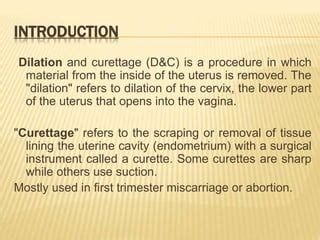Intro
Discover 5 effective ways Dilation and Curettage (D&C) works, including diagnostic, therapeutic, and surgical procedures, to treat menstrual issues, remove uterine lining, and promote womens health through minimally invasive techniques and post-operative care.
The dilation and curettage procedure, commonly referred to as D&C, is a surgical intervention used to remove tissue from inside the uterus. This procedure is often performed to diagnose and treat conditions such as abnormal uterine bleeding, to remove tissue after a miscarriage, or to remove polyps or fibroids. Understanding how D&C works is crucial for individuals who are considering or preparing for the procedure.
D&C is typically performed in a hospital or outpatient surgical facility. The procedure involves two main steps: dilation and curettage. Dilation refers to the process of opening the cervix, which is the lower, narrow part of the uterus, to allow for the insertion of surgical instruments. Curettage involves the use of a special instrument called a curette to remove tissue from the uterus.
The D&C procedure is relatively straightforward and is often performed under local or general anesthesia to minimize discomfort. The choice of anesthesia depends on the individual's overall health, the reason for the procedure, and personal preference. After the procedure, individuals may experience some side effects, such as cramping, bleeding, or dizziness, but these are usually temporary and manageable with rest and medication.
Introduction to D&C Procedure

The D&C procedure is a valuable diagnostic and therapeutic tool in the field of gynecology. It allows healthcare providers to collect tissue samples for examination, which can help diagnose conditions such as endometrial cancer or hyperplasia. Additionally, D&C can be used to treat conditions like menorrhagia, which is characterized by abnormally heavy or prolonged menstrual bleeding.
Benefits of D&C

There are several benefits associated with the D&C procedure. For instance, it can provide relief from abnormal uterine bleeding, which can significantly improve an individual's quality of life. D&C can also be used to remove tissue that is causing discomfort or other symptoms, such as polyps or fibroids. Furthermore, the procedure can help diagnose conditions that may require further treatment, allowing for early intervention and potentially improving outcomes.
Diagnostic Benefits
The diagnostic benefits of D&C are significant. By collecting tissue samples from the uterus, healthcare providers can examine the tissue for abnormal cell growth, inflammation, or other conditions. This information can be used to develop an effective treatment plan, which may include medication, surgery, or other interventions.Therapeutic Benefits
In addition to its diagnostic benefits, D&C also has therapeutic benefits. The procedure can be used to treat conditions such as menorrhagia, which can have a significant impact on an individual's daily life. By removing the tissue that is causing the bleeding, D&C can provide relief from symptoms and improve overall health.How D&C Works

The D&C procedure typically involves the following steps:
- Preparation: The individual is prepared for the procedure, which may include changing into a hospital gown and removing any jewelry or other items that may interfere with the procedure.
- Anesthesia: Local or general anesthesia is administered to minimize discomfort during the procedure.
- Dilation: The cervix is dilated to allow for the insertion of surgical instruments.
- Curettage: A curette is used to remove tissue from the uterus.
- Recovery: The individual is monitored during the recovery period, which may include receiving pain medication or other treatments to manage side effects.
Pre-Procedure Preparation
Pre-procedure preparation is essential to ensure a smooth and successful D&C. This may include avoiding certain medications, such as blood thinners, and abstaining from food and drink for a specified period before the procedure.Post-Procedure Care
Post-procedure care is also crucial to promote healing and minimize the risk of complications. This may include resting, avoiding heavy lifting or strenuous activities, and taking medication as directed to manage pain and other side effects.Risks and Complications

As with any surgical procedure, there are risks and complications associated with D&C. These may include:
- Infection: There is a risk of infection with any surgical procedure, which can be managed with antibiotics.
- Bleeding: Excessive bleeding is a potential complication of D&C, which can be managed with medication or additional surgical interventions.
- Uterine perforation: There is a small risk of uterine perforation, which can be managed with surgical repair.
Minimizing Risks
To minimize the risks associated with D&C, it is essential to follow the healthcare provider's instructions carefully. This may include attending follow-up appointments, taking medication as directed, and reporting any concerns or symptoms promptly.Managing Complications
In the event of a complication, it is essential to seek medical attention promptly. This may include contacting the healthcare provider or seeking emergency care, depending on the severity of the symptoms.Alternatives to D&C

There are alternatives to D&C, depending on the individual's specific needs and circumstances. These may include:
- Medical management: Certain conditions, such as menorrhagia, can be managed with medication.
- Surgical alternatives: Other surgical procedures, such as endometrial ablation, may be suitable alternatives to D&C.
- Watchful waiting: In some cases, watchful waiting may be recommended, which involves monitoring the individual's symptoms and adjusting the treatment plan as needed.
Evaluating Alternatives
Evaluating alternatives to D&C requires careful consideration of the individual's specific needs and circumstances. This may involve discussing the options with a healthcare provider, weighing the potential benefits and risks, and making an informed decision.Choosing the Best Option
Choosing the best option requires careful evaluation of the individual's specific needs and circumstances. This may involve considering factors such as the underlying condition, overall health, and personal preferences.Conclusion and Next Steps

In conclusion, D&C is a valuable diagnostic and therapeutic tool in the field of gynecology. By understanding how D&C works, individuals can make informed decisions about their care and take an active role in managing their health. The next steps may include discussing the procedure with a healthcare provider, preparing for the procedure, and following post-procedure instructions carefully to promote healing and minimize the risk of complications.
We invite you to share your thoughts and experiences with D&C in the comments below. If you have any questions or concerns, please do not hesitate to reach out. Additionally, if you found this article informative and helpful, please consider sharing it with others who may benefit from this information.
What is the purpose of a D&C procedure?
+The purpose of a D&C procedure is to diagnose and treat conditions such as abnormal uterine bleeding, remove tissue after a miscarriage, or remove polyps or fibroids.
What are the benefits of D&C?
+The benefits of D&C include providing relief from abnormal uterine bleeding, removing tissue that is causing discomfort or other symptoms, and helping to diagnose conditions that may require further treatment.
What are the risks and complications associated with D&C?
+The risks and complications associated with D&C include infection, bleeding, and uterine perforation. However, these risks can be minimized by following the healthcare provider's instructions carefully and seeking medical attention promptly if any concerns or symptoms arise.
